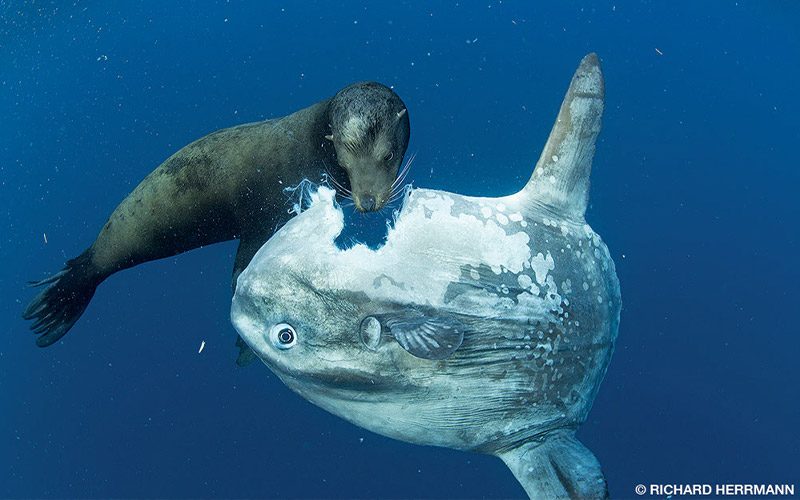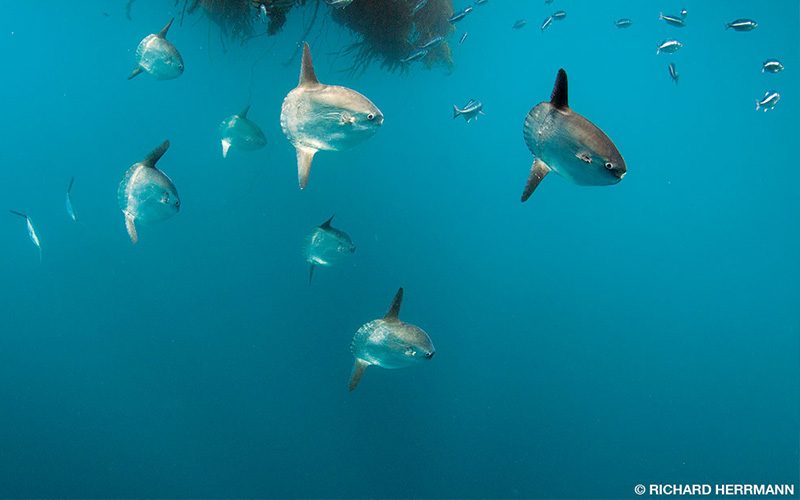With specimens weighing nearly 5,000 pounds, Mola molas, also known as ocean sunfish (or just molas), are the heaviest bony fish in the world. Only in the last 20 years have divers and photographers begun to get quality encounters with these compellingly weird creatures. Found in tropical and temperate waters around the globe, they are actually fairly common animals. There were relatively few still or video images of Mola molas until the early- to mid-1980s, and encounters underwater were considered quite rare. But there are more divers with cameras today and more divers exploring the places where molas are found.
Although divers encounter these fish in the Azores, the Mediterranean and even Florida, two of the best spots for mola encounters are the open sea off the California coast and the reef drop-offs of Bali. The outer edges of kelp forests, elevated parts of the seafloor and reef drop-offs are features that commonly draw these pelagic animals closer to shore.

Mola molas are drawn to near-shore areas mainly by cleaning stations, where reef fish help rid them of bothersome parasites. Molas carry loads of parasites, both internally and externally. Large, stringy parasitic copepods can be seen attached to many molas. The fish are often found basking on the sea surface, exposing their flat sides to seagulls for cleaning — hence their common name: ocean sunfish. Even divers assist the occasional cooperative mola by pulling off a parasite or two.
The cornerstone of the mola’s diet is jellyfish and other gelatinous zooplankton. When it finds food, the fish uses its relatively tiny mouth, which is filled with bony plates, to crush it before swallowing. Mola molas grow very quickly — one captive individual gained 880 pounds in just 14 months and had to be removed from its aquarium by helicopter. Of course, that one was fattened up on squid and fish. The amount of nutritionally poor salps and jellyfish required for a 1,000-pound fish to maintain its weight in the wild is extraordinary. It’s rare to observe molas actively feeding in the wild, but during population explosions of tiny jellies called “by-the-wind sailors” (Velella velella), the fish can be seen on the ocean surface slurping them down with vigor.
Molas have a thick layer of inedible gristle, which makes preying on them a lot of work. While sharks, orcas and sea lions will occasionally eat them, they typically do so only during times of food stress. Sea lions, for example, resorted to hunting Mola molas during warm-water events in 2015 and 2016 that diminished forage fish populations off the California coast. The sea lions would shake the hapless molas at the surface, ripping open their vulnerable underbellies. The pinnipeds would then eat just the meat and organs they could easily access and then leave the majority of the expired mola to sink slowly into the blue.

Approaching a mola is easiest when it’s at an active cleaning station — divers can sometimes get within a few feet of them. Very large free-swimming molas in the open sea may also be approachable. The challenge can be getting in front of the animal for some face time and not getting stuck photographing its back end as it swims away. The key is a slow, calm approach — molas will leave if they perceive signs of aggression.
The absolute craziest Mola mola event I ever witnessed was the appearance in the mid-1990s of thousands of them seemingly everywhere off the coast of San Diego, Calif. My buddy and I pulled up to a drifting kelp paddy, jumped in the water and were shocked to see close to 50 adult molas swimming around us. Most were being cleaned by halfmoon fish and did not care about our presence. We have never again seen as many as we did that year, but we keep heading offshore just in case.

| © Alert Diver — Q3 2017 |